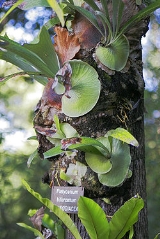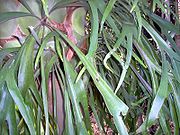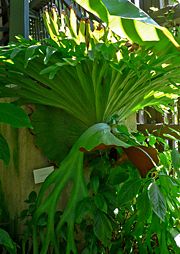
Platycerium
Encyclopedia
Platycerium is a genus of about 18 fern
Fern
A fern is any one of a group of about 12,000 species of plants belonging to the botanical group known as Pteridophyta. Unlike mosses, they have xylem and phloem . They have stems, leaves, and roots like other vascular plants...
species in the polypod family, Polypodiaceae
Polypodiaceae
Polypodiaceae is a family of polypod ferns, which includes more than 60 genera divided into several tribes and containing around 1,000 species. Nearly all are epiphytes, but some are terrestrial.-Description:...
. Ferns in this genus are widely known as staghorn or elkhorn ferns due to their uniquely-shaped frond
Frond
The term frond refers to a large, divided leaf. In both common usage and botanical nomenclature, the leaves of ferns are referred to as fronds and some botanists restrict the term to this group...
s. This genus is epiphytic and is native to tropical and temperate areas of South America
South America
South America is a continent situated in the Western Hemisphere, mostly in the Southern Hemisphere, with a relatively small portion in the Northern Hemisphere. The continent is also considered a subcontinent of the Americas. It is bordered on the west by the Pacific Ocean and on the north and east...
, Africa
Africa
Africa is the world's second largest and second most populous continent, after Asia. At about 30.2 million km² including adjacent islands, it covers 6% of the Earth's total surface area and 20.4% of the total land area...
, Southeast Asia
Southeast Asia
Southeast Asia, South-East Asia, South East Asia or Southeastern Asia is a subregion of Asia, consisting of the countries that are geographically south of China, east of India, west of New Guinea and north of Australia. The region lies on the intersection of geological plates, with heavy seismic...
, Australia
Australia
Australia , officially the Commonwealth of Australia, is a country in the Southern Hemisphere comprising the mainland of the Australian continent, the island of Tasmania, and numerous smaller islands in the Indian and Pacific Oceans. It is the world's sixth-largest country by total area...
and New Guinea
New Guinea
New Guinea is the world's second largest island, after Greenland, covering a land area of 786,000 km2. Located in the southwest Pacific Ocean, it lies geographically to the east of the Malay Archipelago, with which it is sometimes included as part of a greater Indo-Australian Archipelago...
1.
Description
Platycerium sporophyteSporophyte
All land plants, and some algae, have life cycles in which a haploid gametophyte generation alternates with a diploid sporophyte, the generation of a plant or algae that has a double set of chromosomes. A multicellular sporophyte generation or phase is present in the life cycle of all land plants...
s (adult plants) have tufted roots growing from a short rhizome that bears two types of fronds, basal and fertile fronds. Basal fronds are sterile, shield or kidney shaped and laminate against the tree and protect the fern's roots from damage and desiccation. In some Platycerium species the top margin of these fronds forms an open crown of lobes and thereby catches falling forest litter and water.


Some species of Platycerium are solitary having only one rhizome. Other species form colonies when their rhizomes branch or when new rhizomes are formed from root tips. If the conditions are right the spores will germinate naturally on surrounding trees. Platycerium gametophytes are a small heart shaped thallus.
Platycerium have diverged into four natural groups3. Several Platycerium are strongly adapted to xeric conditions and the drought tolerating mechanism Crassulacean Acid Metabolism
Crassulacean acid metabolism
Crassulacean acid metabolism, also known as CAM photosynthesis, is a carbon fixation pathway that evolved in some plants as an adaptation to arid conditions. The stomata in the leaves remain shut during the day to reduce evapotranspiration, but open at night to collect carbon dioxide...
has been reported for P. veitchii3.
Cultivation
The species Platycerium bifurcatumPlatycerium bifurcatum
Platycerium bifurcatum, commonly known as the Elkhorn Fern, is a Platycerium species of fern. It is native to southeastern Australia, in New South Wales, Queensland, and on Lord Howe Island...
and Platycerium superbum
Platycerium superbum
Platycerium superbum, commonly known as the Stag Horn Fern, is a Platycerium species of fern.. It is native to Australia, in east central New South Wales north of Nabiac and in Queensland...
are commonly cultivated as ornamental plant
Ornamental plant
Ornamental plants are plants that are grown for decorative purposes in gardens and landscape design projects, as house plants, for cut flowers and specimen display...
s. These oddly-shaped ferns grow on trees and rocks and can be found in gardens, especially tropical garden
Tropical garden
A tropical garden features tropical plants and requires good rainfall or a decent irrigation or sprinkler system for watering. These gardens typically need fertilizer and heavy mulching....
s.
Staghorns can be propagated
Plant propagation
Plant propagation is the process of creating new plants from a variety of sources: seeds, cuttings, bulbs and other plant parts. Plant propagation can also refer to the artificial or natural dispersal of plants.-Sexual propagation :...
by spores produced on the underside of the fertile fronds. Colonial Platycerium can also be vegetatively propagated by carefully dividing large healthy ones into smaller, separate plants. These new plants can then be attached to board mounts or be strapped to trees until they take to the tree themselves.
A mature staghorn can grow more than 1 metres (3.3 ft) wide. When positioned well, Platycerium species are able to add focal points, privacy
Privacy
Privacy is the ability of an individual or group to seclude themselves or information about themselves and thereby reveal themselves selectively...
, and a tropical look to gardens.

